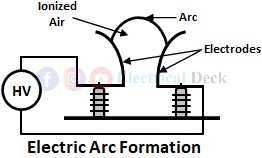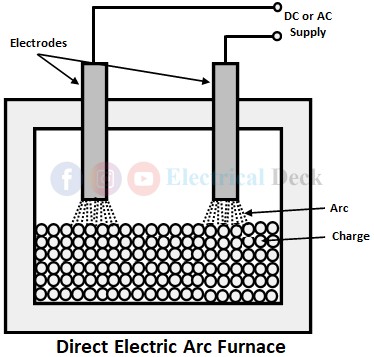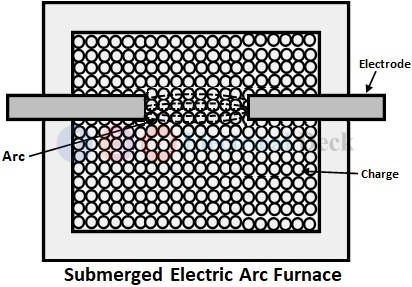What is an Electric Arc?
An electric arc is a flow of electric current in the form continuous spark in a circuit. We know that atmosphere is a poor conductor of electric current. When a high voltage is applied across an air gap, the air gets ionized under electrostatic forces, and it starts acting as a conductor for the flow of current. Thus the current starts to flow in the air gap in the form of a continuous spark called an arc.
In order to strike an arc, high voltage is required which can be obtained from a step-up transformer. But once the arc is initiated a normal voltage is sufficient to maintain the arc.
Alternatively, an arc can also be produced by short-circuiting two low voltage electrodes momentarily and then moving them back. On doing so, an arc will strike between two electrodes through which electric current flows from one electrode to another electrode.
The arc initiated between two electrodes produces heat and by using different types of electrodes such as carbon or graphite, temperatures up to 3500°C can be obtained. Thus the heating of material can be done by using this principle in electric arc furnaces.
Electric Arc Furnace :
Generally, arc furnaces are made in a cylindrical shape, but conical shape furnaces are employed due to the availability of large surface area per unit volume, less power consumption, less radiation loss, and reduction in melting point. The arc chamber of the furnace consists of a suitable acid or basic refractory lining supported on a metal frame.
The electrodes are held by a clamping mechanism inside the furnace from the top or sides of the chamber and are placed such that they can be easily replaced or adjusted. A charge door is provided on the side of the furnace shell through which the charge to be heated is kept and molten metal is taken out.
Electrodes Used in Arc Furnace :
The type of electrodes used in an electric arc furnace will depend upon conductivity, insolubility, mechanical strength, non reactiveness, etc. Generally, electrodes made up of carbon and graphite with a diameter of 18-27 cm are usually employed. In the case of small furnaces, carbon electrodes are used for the manufacturing of ferroalloys, aluminum phosphorous, etc. For electrochemical furnace and electrolytic production of aluminum, self-baking electrodes are used.
Types of Electric Arc Furnaces :
There are three types of electric arc furnaces,- Direct electric arc furnace,
- Indirect electric arc furnace, and
- Submerged electric arc furnace.
Direct Electric Arc Furnace :
In a direct arc furnace, the arc is formed between the electrodes and the charge to be heated as shown below. In this type of furnace, the charge acts as another electrode. There are two carbon or graphite electrodes and the arc is formed between the electrode and charge at two places.
In this type of heating, high temperatures can be obtained since the arc is produced directly with the charge to be heated, and also there will be additional heat generation in the charge due to the flow of current through it.
In the case of a single-phase arc furnace, two electrodes are placed vertically from the top of the furnace into the charge. Whereas in the case of a three-phase arc furnace, three electrodes placed at the corners of an equivalent triangle are used which produces three arcs, the charge itself thus forms a star point.
Also, one of the important features of a direct arc furnace is that, due to the flow of current in the charge, automatic stirring action is produced in the charge by electromagnetic force set up by the current. This type of arc furnace is mostly used for the production of steel and is advantageous as compared to the cupola method for the production of steel.
Indirect Electric Arc Furnace :
In a direct arc furnace, we have seen that the arc formed will be in direct contact with the charge to be heated. But in an indirect furnace, the arc formed will be not in direct contact with the charge. In an indirect furnace, the arc is formed between two electrodes near the charge, and heat produced by the arc is transferred to the charge by radiation as shown below.
In this furnace, the electrodes are projected through the chamber at each end along the horizontal axis. The arc is formed by bringing the electrodes in contact for a very short time and then withdrawing them back. Since there is no direct contact of the arc with the charge, temperatures obtained in an indirect arc furnace will be lower than that of a direct arc furnace.
Also, there is no inherent stirring action in charge due to the absence of current flow and thus furnace must be rocked mechanically. The heat produced in the charge is not only by radiation but also by conduction from the refractory lining during rocking action. By varying arc length i.e., by varying the distance between electrodes, power input to the furnace can be regulated.
This type of furnace is usually of single-phase and its size is limited. The applications of indirect electric arc furnaces are melting of non-ferrous metals, iron foundries where there is a need for molten metal, etc.
Submerged Electric Arc Furnace :
In a submerged arc furnace, the electrodes are immersed in the charge as shown in the below figure. This type of furnace is used for the manufacture of ferroalloys such as Fe-Mn, Si-Mn, Fe-Si, Mg-Si and etc.
The resistance offered by the charge to the flow of current will generate heat in it. The power to the furnace is controlled by varying the applied voltage or by varying arc length.
Power Supply and Control of Arc Furnace :
The power supply to an electric arc furnace is usually of low voltage and high current. The electric arc furnace finds application mostly in the melting of ferrous or non-ferrous metals, for this process large power is required due to which the current required will be huge.
The voltage used in an electric arc furnace is in the range of volts, and the value of current will be in the order of several hundred amperes. The following are the reasons why low voltage high current is used for electric arc furnaces,
- We know that the heat is proportional to the square of the current, hence high current is used.
- The voltage to the furnace is limited due to insulation and safety considerations.
- By using low voltage and high current electrodes near the charge that remains away from the roof, the life of the refractory lining in the furnace is increased.
The power input to the furnace can be controlled by varying the voltage applied or by varying the length of the arc which can be done by moving the electrodes.





